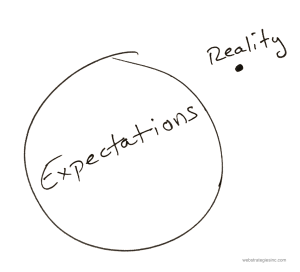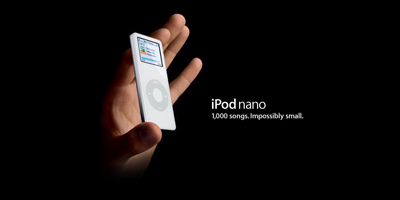
When was the last time you told someone about the milk you purchased? Probably never. Most people have never shared an experience buying milk, because when you buy milk, you almost always get exactly what you expect.
What would it take to tell someone about your milk-buying experience? If the milk was rancid, would you tell someone? What if you bought a new, special milk that tasted better and greatly improved your health? Would you tell someone then?
Word of mouth, both positive and negative, only occurs when expectations don’t match the reality. And if word of mouth, the most powerful marketing channel, is driven largely on customer expectations, businesses should work tirelessly to understand those expectations. Only then can a business work to exceed them.
So, what is it customers expect from you?
No matter the business, customers expect from you what they can get from the largest, most successful brands. The customer doesn’t care if you’re small. The customer doesn’t care if you haven’t been in business very long. The customer doesn’t care if you lack financial resources. If Amazon offers two-day shipping, customers expect the same from all online retailers. If Apple replaces a faulty device on the spot, so should all manufacturers. Anything less is a disappointment.
To generate positive word of mouth, your company must exceed customer expectations. To exceed customer expectations, you must have a customer-centric mentality. To do that, you need the following approach:
Obsess Over Your Customer
The most successful brands obsess over their customers. They seek to know as much as they can about their customers, then use that data to shape and personalize the customer experience.
To get started, talk to your customers, sales reps, and customer service personnel. Develop buyer persona types and tailor your messaging accordingly. Marketing automation and CRM software is now affordable to everyone. Take advantage!
Seek ongoing feedback from customers about your performance. Tailor your surveys around the areas clients value the most. Keep track of performance and look for new ways to go above and beyond.

Know Your Industry Deeply
I don’t condone obsessing over your competition; however, in order to know your customer deeply, you have to understand their past experiences. To differentiate yourself as quickly as possible, find the shortcomings in your industry and work to solve the problem. Your solutions will become a powerful differentiator in the marketplace.
Make It About Them
Humans purchase because they want to change an element of their situation. They want to feel, become, or achieve something. They buy for themselves, not for you.
Therefore, our job as marketers or salespeople is not to sell people, but to help them buy. This may sound like the same thing, but read it again. There’s a very distinct difference.
To help customers buy, we must know both the customer and their journey. Next, we must craft messaging that shows the customer succeeding in their journey of who or what they want to become.
Take Apple as an example. When they advertise their product, they focus on the user, not the product. Instead of talking about the iPhone camera, they show a parent Facetiming with their daughter. Instead of talking about an iPod’s hard drive space, they told us how many songs fit in our pocket.

Your user is the context. Your user, not your product or service, is the story. (tweet this!)
As stated by Bryan Eisenberg, “our job (as marketers) is to help customers become the heroes on their journey.” This idea is the very foundation of customer-centric marketing, and the first steps to delighting your customers.
Delighting Your Customers
Delighting your customers begins with doing what you promise, then finding opportunities to go above and beyond expectations. Fall outside the circle of expectations, and you become remarkable.
Sound difficult? It’s not. Here are four practical ways to do it:
Eliminate Ambiguity
Communication is considered the key to a successful marriage. The same goes for a business relationship. The more transparent you are, the more comfortable you are to work with. Identify ways to eliminate as much uncertainty around your process by updating and informing your clients as often as possible.
You see this frequently with ecommerce businesses who email customers when orders are received, shipped, and delivered. Service companies replicate this behavior by sending service reminders, summaries, and billing reminders.
Maintaining transparent and accessible documentation further eliminates customer uncertainty. Larger businesses offer online customer portals, while smaller businesses can share files via Google Drive or give customers access to project management software.
Every milestone is an opportunity to communicate with the customer and eliminate ambiguity. Companies should explore every opportunity to bring more transparency and communication to their process.
Implement A Process For Soliciting Feedback
You can’t fix problems you don’t know exist. Therefore, companies should implement a system for soliciting feedback from their customers. This system should be both process-driven and able to produce measurable results.
Process-Driven: obtaining feedback should not simply happen when it’s convenient. Instead, it should be baked into day-to-day operations, with a defined quota. For example, every customer should be called on once per quarter, or a response should be obtained from every customer twice per year.
Measurable results: using numbers to judge performance will allow for better tracking over time and allow for easier analysis. Net Promoter Score, or NPS, is a popular question for measuring client satisfaction. NPS asks customers how likely they are to recommend you to a friend or colleague, on a scale from 1-10 (with 10 representing “highly likely”). NPS data is published for many large brands and industries, allowing you to compare your results with others.
While it’s tempting to get caught up in scores and numbers, the true purpose of surveying customers is to uncover any festering issues undetectable during normal day to day interaction. The person calling on customers needs to be skilled at understanding tone, asking penetrating questions, and reading between the lines. Issues identified during these calls should be addressed as quickly as possible.
‘Wow’ Them When Responding To Mistakes
Recovering well from a mistake can hold you in a better light than if you had never made the mistake. Therefore, a mistake should be viewed as an opportunity.
When a mistake or service issue occurs, customers have an expectation for how you will respond. Their expectation will differ depending on your industry. In some industries, they will be surprised if you do anything. In others, they expect you to correct the issue in a timely manner. Whichever the case, meeting, then exceeding those expectations will hold you in the best light possible.
Establish Customer Experience “WIGS”
If everything is important, nothing is important. Therefore, you must develop your few wildly important goals, or “WIGS”, for delivering exceptional customer service.
Your WIG begins with a lag metric, or what happens as a result of certain behavior. An NPS score is a suitable lag metric for customer experience.
Next, identify the two to three behaviors that lead to your lag metric. This could be number of times a customer is contacted per month or days in production. Then, begin tracking and reporting these on a weekly basis to ensure you are hitting your targets. Successfully executing your lead metrics should imply you will achieve your desired lag metric, so make sure your lead metrics relate directly to the intended outcome.
Closely tracking and reporting lead activity will increase the rate that activity occurs. Which, as a result, increases the chances of achieving the desired outcome.
Still struggling to understand the lead and lag metric approach? Let's look at it in the context of a weight loss program.
If your goal is to lose 50 pounds in 6 months, then two pounds per week is your lag metric (as is losing 50 pounds at the end of six months). Your lead metrics (the activity you can directly control), could be running 6 miles per week and consuming 1000 fewer calories per day. If you successfully achieve your lead metrics, you will lose two pounds per week and 50 pounds in six months.
Think you can’t apply any of these concepts to your own company? Think again. Not one of these ideas requires a major financial investment. More than anything, it's a philosophy; a paradigm shift from simply delivering what you sell, to going above and beyond the expectations.
Now ask yourself: are you delivering a remarkable customer experience, or are you just selling milk?





Agree, disagree, or just have something to add?
Leave a comment below.